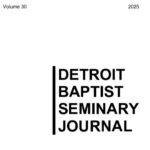The Poetic Nature of the Psalms
 While the Psalms are familiar to many Christians, understanding them is often difficult. Part of this difficulty relates to the poetic nature of the Psalms. With this entry I will describe the type of poetry found in the Psalms.
While the Psalms are familiar to many Christians, understanding them is often difficult. Part of this difficulty relates to the poetic nature of the Psalms. With this entry I will describe the type of poetry found in the Psalms.
Approximately one-third of the Bible is written in poetry. Because poetry is a part of the fabric of biblical literature, it is vital for the reader to understand the nature of poetry. A starting point for interpreting the Psalms is to recognize that the individual psalms are categorized as religious lyric poetry. What I mean by religious is that the content of each psalm is tethered to the Old Testament religious system. By lyric poem, each psalm is generally characterized by its abbreviated nature. A lyric poem such as Psalm 1 could be contrasted with the book of Job. Job is predominantly poetic and narrating a complex story from a phase of Job’s life. The poetry of Job differs from Psalm 1 in length as well as content. Since each psalm is a lyric poem, this indicates that each poem is a self-contained unit.
For further clarification, we could compare poetry with prosaic literature and common speech, as illustrated by the following chart (Tremper Longman, Literary Approaches to Biblical Interpretation [Grand Rapids: Zondervan, 1987], 121). Prosaic writing as found in the historic literature of the Bible is more structured than spoken language while poetry is even more highly structured than prosaic writing.
Hebrew poetry is characterized by brevity in line length, parallelism, and figurative language. If we compare the line length of Psalm 1 with a narrative such as Judges 1, it is readily apparent that the length of each line in Psalm 1 is shorter than the length of line in Judges 1. Psalm 1:2 is a familiar example of poetic parallelism.
But whose delight is in the law of the LORD,
and who meditates on his law day and night.
The godly man’s “delight is in the Law of the LORD.” The second part of this verse parallels the first part with a slight expansion, “who meditates on his law day and night.” The parallelism develops what the psalmist’s point is: the godly man’s joy in the Law is demonstrated by his constant study of the Law (for a good synthesis on parallelism, see Klein, Blomberg, and Hubbard, Introduction to Biblical Interpretation, 289–303). Verse 3 of this psalm demonstrates the use of figures when it compares the blessedness of the godly man to “a tree planted by the streams of water, which yields its fruit in season and whose leaf does not wither” (ibid., pp. 303–16).
Though much more could be said about the poetic nature of the Psalms, my post is designed to briefly acquaint you with this subject. For us to get more out of reading the Psalms, I recommend that you get a modern study Bible and start reading. May God grant that we gain a greater appreciation for the Old Testament worship manual, the Psalms!



